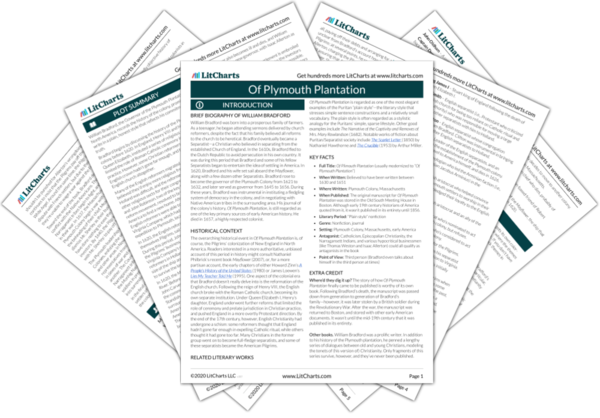Summary
Analysis
The year is now 1627, and Isaac Allerton returns from his visit to England, having raised two hundred pounds from the remaining Virginia Company investors. He’s also managed to reduce the Pilgrims’ debts to 1800 pounds, paid in installments of 200 pounds and beginning in 1628. The Pilgrims now have a clear schedule for paying off their debts. They divide the debt evenly between households.
Allerton succeeds in talking down the English investors. The fact that he is able to do so testifies to the Pilgrims’ sophistication as negotiators (refined over the last fifteen years!) as well as their new economic self-sufficiency.
Themes
Quiz
Test Yourself
In the winter, Bradford recalls, a Virginia-bound ship is cast ashore in a storm, near Plymouth. The survivors make contact with Indians, who lead them to the Plymouth Plantation. Bradford arranges to repair the sailors’ boat, and also offers them corn and other supplies. The ship sets sail again, but is caught in another storm, and this time the passengers beg to live at the Plymouth colony until they can arrange further transportation. Bradford consents, recognizing that both the Pilgrims and the passengers stand to benefit from trade. Later in the summer, the passengers set sail for Virginia.
The Pilgrims continue to treat visitors with kindness and hospitality, going out of their ways to offer them free food and shelter. Bradford’s hospitality isn’t motivated entirely by generosity, however—he recognizes, quite perceptively, that he’s building important trading alliances with the Virginia colonies.
Themes
Quiz
Test Yourself
The Pilgrims construct more boats for themselves. When ships arrive from England, they prepare to send Isaac Allerton back to England with full power to negotiate a final agreement with the Virginia Company’s remaining investors. Allerton is instructed to obtain a patent for more land, if possible.
The Pilgrims press their advantage by sending Allerton back to England to further reduce their debt and obtain more land for themselves—a sign of their growing population and economic power (and of how their goals seem to have changed from merely seeking religious freedom).
Themes
Quiz
Test Yourself
The Pilgrims receive messages from the Dutch colonists who live further south. The Dutch praise the Pilgrims for their success and ask if the Pilgrims are willing to sell or trade beaver skins. The Pilgrims send a message that they are willing to trade with the Dutch and inquire about prices for beaver skin. Hereafter, the Pilgrims maintain a steady trade alliance with the Dutch colony.
As the Pilgrims’ colony grows more successful, they trade more and more frequently with their neighbors, such as the Dutch settlers in Manhattan (at the time, the colony of New Amsterdam). The Pilgrims have had good relations with the Dutch in the past, so it’s unsurprising that they forge a strong trading alliance now.
Themes
Quiz
Test Yourself
Get the entire Of Plymouth Plantation LitChart as a printable PDF.

The Pilgrims send Allerton back to England with a contract, clarifying that the Pilgrims will pay their debts over the course of the following years, in return for which the investors will furnish them with supplies. Finally, the agreement specifies that the Pilgrims will maintain control of their land and trade after paying off their debts.
Thanks to Allerton’s negotiating talents, the Pilgrims have a lighter, more manageable schedule for paying off their remaining debts. Crucially, the Pilgrims reach an agreement whereby they’ll continue living in their New England colony after they’ve paid off their debts—control of the land will remain with them perpetually.
Themes
Quiz
Test Yourself












